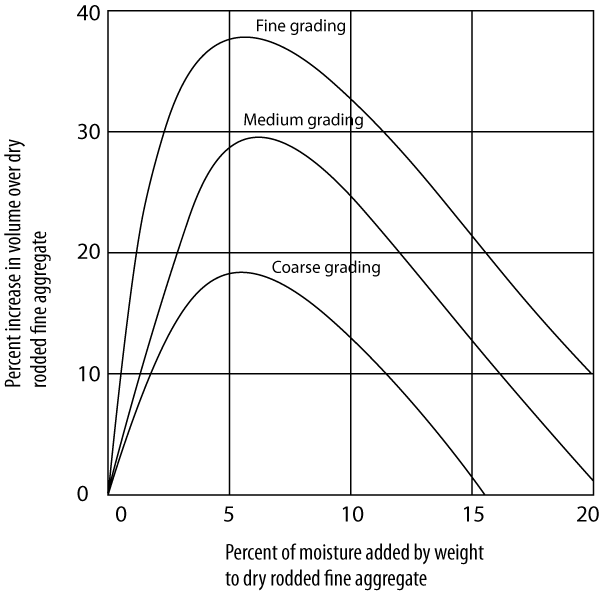Sand is small grains of silica (SiO2) formed by the decomposition of rocks. It is one of the most important construction materials. It is broadly used in concrete, cement mortar, lime mortar, earth filling, etc.
Contents [show/hide]
What is Bulking of Sand?
The increase in the volume of sand due to increase in moisture content is known as bulking of sand. A film of water is created around the sand particles which forces the particles to get a side from each other and thus the volume is increased.
The increase in moisture in sand increases the volume of sand. The volume increase in dry sand is known as the bulking if sand. Bulking of sand depends on the quantity of moisture in the sand and also the size of the particles. Five to eight percent of the increase in moisture in the sand can increase the volume of sand up to 20 to 40 percent. Again the finer the sand is more will be the increase in volume and increase in volume will be relatively less for coarser sand.

Bulking of sand depends on the moisture in the sand. But when the moisture is increased by adding more water, the particles of sand gets packed near each other as the film around the sand particles breaks and the bulking of sand is reduced. Dry sand and the send completely filled with water will have the exact volume. This principle is used to determine the percentage of bulking of sand in a given sample
Bulking of Sand Significance
In simplified terms, it can be said that bulking of sand is simply the looseness of soil without compacting. Usually, water reduces the pores in sand and compacts the sand.
Sand is used in concrete for reduction of segregation and fill out the pores between cement and coarse aggregates. For example, we need 1 m3 of sand in concrete, we need to know the approximate sand bulkage value. If the given sample has a bulkage of 25% then we need to take 25% more sand or 1.25 times of the sand while volume batching to get 1 m3 of sand for concrete.
If we don’t take this extra amount of sand considering the bulkage value, the total volume will be lessened to 75% after adding water. We know that the quality of concrete depends a lot on the proper proportioning of the contents. Generally, we consider the wet volume of concrete is 1.5 times the volume of dry concrete, in this case, we are typically using approximately 30% of sand bulkage and 20% of wastage. If we do not consider the bulkage of sand, the total quantity will be lessened and will impact on the overall concrete quality.
Test Procedure to Determine the Bulking of Sand
Following steps can be followed to calculate the percentage of bulking of sand in a given sample-
- Fill the measuring cylinder with the sample up to 200 ml mark.
- For accurate measurement steel scale can be used, but no compaction of sand is allowed.
- The sand is to be transferred to a container.
- The measuring cylinder is refilled with 100ml water.
- The measuring cylinder should be refilled with sample sand and stirred with a steel rod.
- Give some time so that the sand can settle.
- The level of sand will be below the 200ml mark this time. Let the present level be “a.”
- So the bulking of sand for this sample will be determined by the following equation-
\[{Bulking\;of \;Sand}= \frac{200-a}{a} \times 100%.\] - The procedure should be repeated twice and the average value of the tree observation will be the percentage of bulking of sand for the given sample.
Sand Articles
- What is sand? Composition, Color, and Types of Sand
- Uses of sand
- What is Sandy Soil?- Uses of Sandy Soil
- How to Improve Sandy Soil
- What is the Bulking of Sand? - Significance & Test Steps
- What is Silica Sand? Sources & Uses of Silica Sand
- Types of Silica Sand
- The Health Risks of Silica Sand
- Bulk Density of Sand
- Specific Gravity of Sand
- Sand Unit Weight

